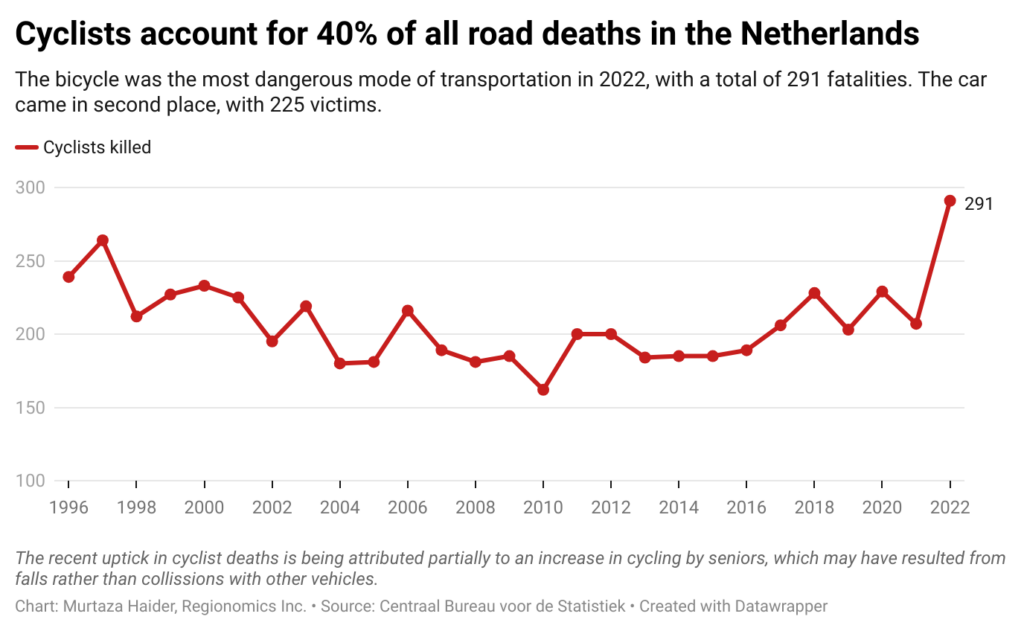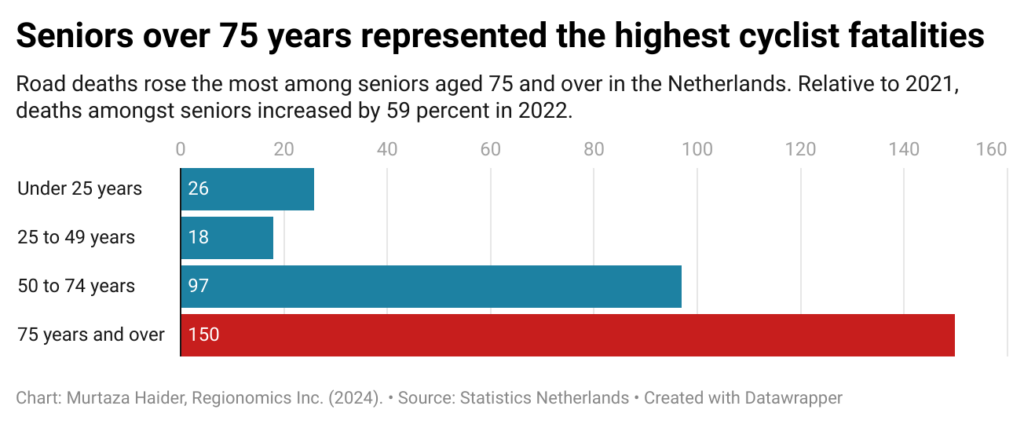The ubiquitous use of cycling as a mode of travel in the Netherlands has an ugly side: cyclist fatalists outnumber road deaths for any other mode. In 2022 alone, 291 cyclists died in the Netherlands, more than motorists or those who walked. Cyclist deaths represented 40 percent of the 737 road fatalities.
Urban planning literature and bicycle enthusiasts in North America always draw attention to the widespread use of bicycles in the Netherlands, where bicycles are an efficient mode of travel that competes with cars and public transit. The Dutch demographics are unique, as are the climate and other enabling factors, such as the older age of the built environment constructed before the War for non-motorized modes, preferential design for bicycle infrastructure in the newly developed neighbourhoods, and relatively flat terrain.

Consider that both Montreal and Amsterdam are located on islands. However, Amsterdam is distinguished for its flat, low-lying areas, while Montreal is known for its most prominent feature, Mount Royal. For cycling, flatness helps, but mountains don’t.
Remember how different these cities are in climate. The average temperature in Amsterdam ranges from 3.5 degrees Celsius in January to 18 degrees in July. Montreal has freezing weather. The average temperature in January is minus 9 degrees Celsius. The mercury regularly reaches north of 25 degrees Celsius in summer. To make this more interesting, Montreal gets tons of snow. There are two things cyclists struggle the most with within Canada: streetcar tracks and snow.
And if you didn’t know, Amsterdam hardly gets any snow that lasts on road surfaces.
More traffic deaths in 2022, particularly among cyclists over 75
Earlier in April 2023, Statistics Netherlands reported increased road deaths in 2022. The main contributor to the growth in fatalities was cyclists over the age of 75. While fatalities increased in 2022 for cyclists and car occupants, the jump was more pronounced for cyclists. In 2022, cyclist deaths increased by 84 and car occupants by 50. The 21 percent increase in road deaths in 2022 over the previous year comprised mostly men, who accounted for 522 deaths.
Road deaths rose the most among seniors aged 75 and over in the Netherlands. Relative to 2021, deaths amongst seniors increased by 59 percent in 2022. Statistics Netherlands noted that “traffic victims aged 50 years and over are relatively likely to be involved in a bicycle accident, while younger victims (under 50) are more likely to be killed in a car accident. In relative terms as well, the number of senior cyclists involved in a fatal road accident increased.”

Collisions with motorized vehicles were responsible for three-fourths of all cyclist deaths in the Netherlands in 2022. Collisions with passenger cars or vans accounted for half of all cyclist deaths. “One quarter of all bicycle deaths were not due to a collision. These cyclists died after a fall, due to becoming unwell, wrong steering, bad road surface, slipperiness, or a foot between the spokes, among other things. Over two thirds of these victims were 70 years of age or older,” noted Statistics Netherlands.
Bicycle is a healthier mode of travel for individuals and the planet. It costs less to install bicycle infrastructure than road and transit infrastructure. Yet, it might only be a feasible mode of travel for some demographics and places. Its wholesale adaption as a mode of travel comes with huge risks. The cycling enthusiasts and planners advocating for its mass adoption seldom mention the risks, which are considerable given that cyclists account for 40 percent of all road deaths in the Netherlands.
Collision or fall are not the only risks cyclists face more than those using other modes of travel. The financial risk is also at play. Since cycling can be done safely for shorter distances than by cars or public transit, those who adopt bicycles to work in North America will limit their employment or residence options. Cyclist commuters must find work near home or home near work. This restricts choice sets for employment and residence, resulting in suboptimal choices.
The bicycle mode share can be expanded by providing safe infrastructure for cyclists in Canada. Yet, the Dutch experience in road safety must not be overlooked, where cyclists represent 40 percent of all road fatalities.

